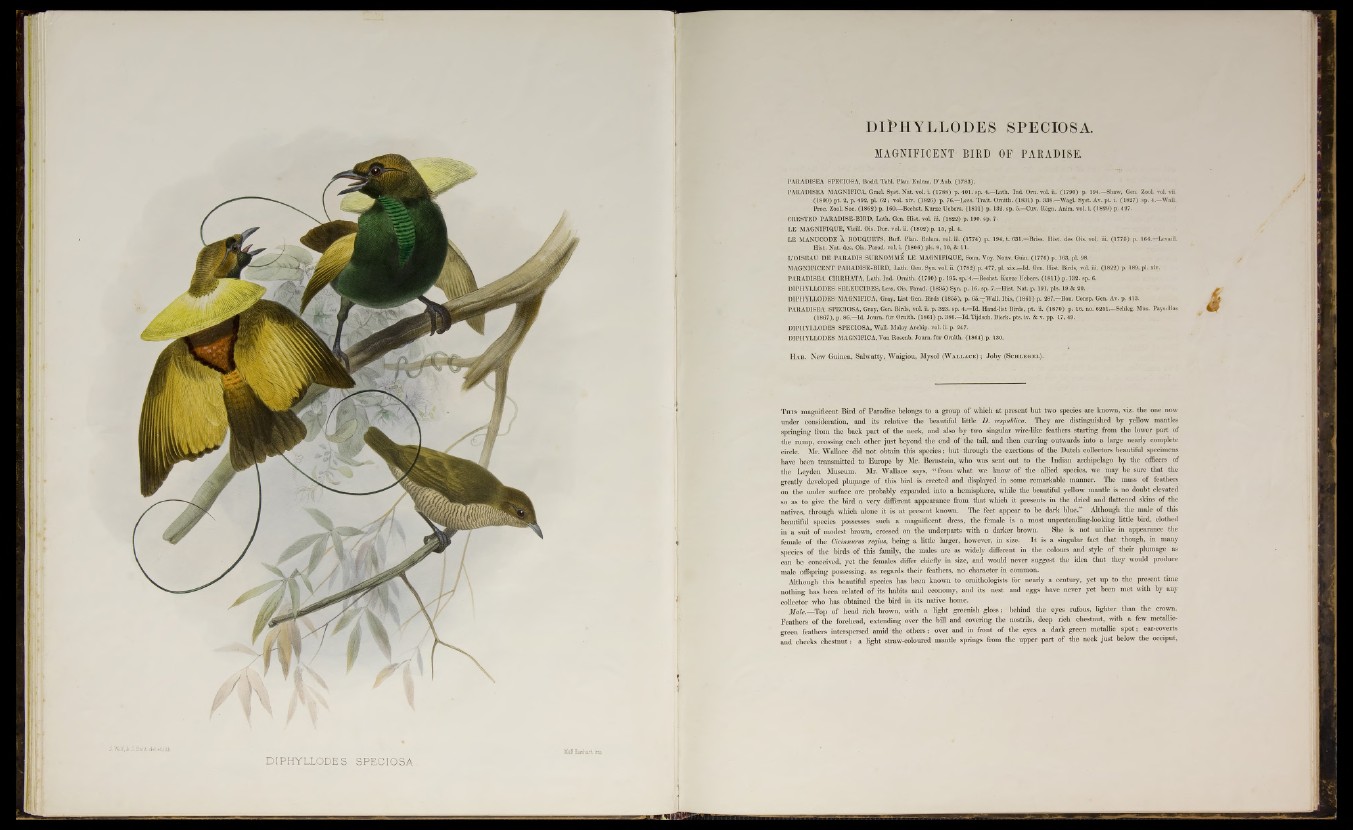
DIPHYI»I,SSpEft;;;JSPEOiJ©3 A
DIPHYLLODES SPECIOSA.
MAGNIFICENT BIRD OF PARADISE,
PARADISEA SPECIOSA, Bodd. Tabi. Plan. Enlum. D’Aub. (1783).
PARADISEA MAGNIFICA, Gmel. Syst, Nat. vol. i . (1788) p. 401. sp. 4.—Lath. Ind. Om. v o i ii. (1 790) p. 194.—Shaw, Gen. Zool. vol. vii.
(1 809) pt. 2, p.'492, pi. 62 ; vol. Xiv. (1826) p. 76.—Less. Trait. Ornith. (1831) p. 338.—Wagl. Syst. Av. pt. i. (1827) sp. 4.—Wall.
Proç. Zool. Soc. (1 862) p. 160.—Bechst. Kurze Uebers. (1 811) p. 132. sp. 5.—Cuv. Règn. Anim. vol. i. (1829) p. 427.
CRESTED PARADISE-BIRD, Lath. Gen. Hist. vol. iii. (1822) p. 190. sp. 7.
LE MAGNIFIQUE, VieiU. Qis. Dor. v o i.'iit||l8 0 2 ) p. 1 6 ,pl. 4.
LE MANUCODE À BOUQUETS, Buff. Plan. Enlum. vol. iii. (1 774) p. 194, t. 631.—Briss. Hist, des Ois. v o l iii. (1 7 7 6 ) p. 166.—Levaill.
Hist. Nat. des. Ois. Parad, vol. i. (4806) pis. 9, 10, & 11.
L’OISEAU DE PARADIS SURNOMMÉ LE MAGNIFIQUE, Sonn. Voy. Nouv. Guin. (1 776) p. 163, pl. 98.
MAGNIFICENT PARADISE-BIRD, Lath. Gen. Syn. vol. ii. (1782) p. 477, pl. xix.—Id. Gen. Hist. Birds, vol. iii. (1822) p. 189, pi. xlv.
PARADISEA CIRRHATA, Lath. Ind. Omith. (1 790) p. 195. sp. 4.—Bechst. Kurze Uebers. (1 811) p. 132. sp. 6.
DIPHYLLODES SELEUCIDES, Less. Ois. Parad. (1 836) Syn. p. l6 ..sp . 7.—Hist. Nat, p. 191, pis. 19 & 20.
D3PHYLLODES MAGNIFICA» Gray, l i s t Gen. Birds (1 8 6 5 ), p. 65.T Wall. Ibis, (1 861) p. 287.—Bòn. Consp. Gen. Av. p. 413.
PARADISEA SPECIOSA, Gray, Gen. Birds, vol. ii. p. 323. sp. 4.—Id. Hand-list Birds, pt. ii. (1 870) p. 16. no. 6251.—Schleg. Mus. Pays-Bas
(1 867), p. 86.—Id. Journ. fur Òraith. (1861) p. 386.—Id. Tijdsch. Dierk. pts. iv. & v. pp. 17, 49.
DIPHYLLODES SPECIOSA, Wall. Malay Archip. vol. ii: p. 247.
DIPHYLLODES MAGNIFICA, V on Rosenb. Journ. fUr Omith. (1 864) p. 130.
H a b . New Guinea, Salwatty, Waigiou, Mysol (W a l l a c e ) ; Joby (Sc h l ég e l ).
T h i s m n g n ifW n t Bird of Paradise belongs, to a group of which at present but two species are known, viz. the one now
under consideration, and its relative the beautiful little D. respublica. They are distinguished by yellow mantles
springing from the back part of the neck, and also by two singular wire-like feathers starting from the lower part of
the rump, crossing each other just beyond the end of the tail, and then curving outwards into a large nearly complete
circle. Mr. Wallace did not obtain this species; but through the exertions of the Dutch collectors beautiful specimens
have been transmitted to Europe by Mr. Bernstein, who was sent out to the Indian archipelago by the officers of
the Leyden Museum. Mr. Wallace says, “ from what we know of the allied species, we may be sure that the
greatly developed pluipage o f . this bird is erected and displayed in some remarkable manner. The mass of feathers
on the under surface are probably expanded into a hemisphere, while the beautiful yellow mantle is no doubt elevated
so as to give the bird a very different appearance from that which it presents in the dried and flattened skins of the
natives, through which alone it is at present known. The feet appear to be dark blue.” Although the male of this
beautiful species possesses such a magnificent dress, the female is a most unpretending-looking little bird, clothed
in a suit of modest hrown, crossed on the underparts with a darker brown. She is not unlike in appearance the
female of the Cicinnurm regius, being a little larger, however, in size. It is a singular fact that though, in many
species of the birds o f this family, the males are as widely different in the colours and style of their plumage as
can be conceived, yet the females differ chiefly in size, and would never suggest the idea that they would produce
male offspring possessing, as regards their feathers, no character in common.
Although this beautiful species has been known to ornithologists for nearly a century, yet up to the present time
nothing has been related o f its habits and economy, and its nest and eggs have never yet been met with by any
collector who has obtained the bird in its native home.
Male.—Top of head rich brown, with a light greenish gloss; behind the eyes rufous, lighter than the crown.
Feathers of the forehead, extending over the bill and covering the nostrils, deep rich chestnut, with a few metallic-
green feathers interspersed amid the others; over and in front of the eyes a dark green metallic spot; ear-coverts
and cheeks chestnut: a light straw-coloured mantle springs from the upper part of the neck just below the occiput,